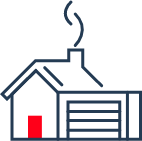As we sail through 2024, the housing market continues to show robust activity, especially for new home purchases.
In fact, according to the Mortgage Bankers Association (MBA) Builder Application Survey (BAS) data for May 2024, mortgage applications for new home purchases have surged by an impressive 13.8 percent compared to the same time last year. This uptick highlights a growing trend among homebuyers turning towards newly built homes amidst a landscape of limited existing-home inventory.
WHAT IS MBA’S BUILDER APPLICATION SURVEY (BAS)?
The MBA’s Builder Application Survey is a crucial tool for tracking and understanding trends in new home purchases. By gathering data from mortgage subsidiaries of home builders across the country, this survey provides early estimates of new home sales volumes at various levels – national, state, and metro.
MONTHLY & YEARLY COMPARISONS
May 2024 has brought promising news, not just on a yearly basis but also month-over-month. Compared to April 2024, there was a 1 percent increase in new home purchase mortgage applications.
This month-to-month growth, combined with the staggering 13.8 percent year-over-year increase, underscores the sustained strength in the new home market. Notably, these figures are presented without any adjustments for typical seasonal patterns, providing a raw and real picture of market dynamics.
FACTORS DRIVING THE INCREASE
Several factors are playing pivotal roles in this upward trajectory. One of the most significant is the ongoing shortage of existing-home inventory, which has driven many buyers to seek out newly constructed homes. This shift is particularly prominent among FHA borrowers, whose share of applications reached 26.5 percent in May – the highest since November 2023.
Another noteworthy trend is the decline in the average loan size for new homes, dropping from over $405,000 in April to $400,150 in May. This reduction may indicate a broader range of affordable new homes becoming available, making the market more accessible to a wider audience.
NEW HOME SALES ESTIMATES: A CLOSER LOOK
The MBA’s estimates put new single-family home sales at a seasonally adjusted annual rate of 702,000 units for May 2024. This marks a slight but meaningful increase from the 699,000 units estimated in April. When looking at unadjusted figures, the MBA estimates there were 63,000 new home sales in May, up from 62,000 in April – a 1.6 percent increase.
Breakdown by Loan Type
Delving into the specifics of loan types used for these new home purchases provides further clarity:
- Conventional loans: 63.4%
- FHA loans: 26.5%
- RHS/USDA loans: 0.3%
- VA loans: 9.8%
Understanding the distribution of loan types helps paint a fuller picture of buyer demographics and financing strategies.
INSIGHTS FROM JOEL KAN
Joel Kan, MBA’s Vice President and Deputy Chief Economist, offers valuable perspective on these trends. He notes the persistent strength in the new home purchase market, driven largely by the lack of existing-home inventory. Kan’s insights suggest that this trend is likely to continue, as more buyers look to new constructions to meet their housing needs.
IMPLICATIONS FOR HOME BUILDERS & BUYERS
For home builders, these trends signal a need for continued focus on new developments. The steady demand for new homes presents opportunities for growth and innovation in home construction.
For potential homebuyers, understanding these market dynamics can be incredibly advantageous. With new homes becoming a primary option, staying informed about loan types and market conditions can help buyers make more informed decisions.
IMPLICATIONS FOR MORTGAGE INSURANCE
Mortgage insurance is a crucial financial tool designed to protect lenders in the event a borrower defaults on their loan, making it possible for more individuals to achieve homeownership, especially those who may not have substantial down payments.
This insurance is typically required for conventional loans when the down payment is less than 20 percent of the home's purchase price. By mitigating the lender's risk, mortgage insurance opens doors for borrowers by allowing them to secure financing with lower initial capital requirements.
For FHA loans, mortgage insurance is mandatory regardless of the down payment amount, further facilitating access to housing for a broader range of buyers. While it adds to the overall cost of the loan, mortgage insurance ultimately serves as a bridge to homeownership, enabling more people to enter the market and invest in their futures.
May 2024’s surge in new home purchase mortgage applications is a testament to the evolving dynamics of the housing market. With existing home inventory lagging, new constructions are stepping in to fill the gap, supported by varied financing options and a broadening range of home prices. As we look ahead, staying attuned to these trends will be key for both home builders and buyers.
And if you need help finding the best homeowners insurance coverage for the best price, start by speaking to a SimplyIOA agent at 833.872.4467 or get a homeowners insurance quote online now.










